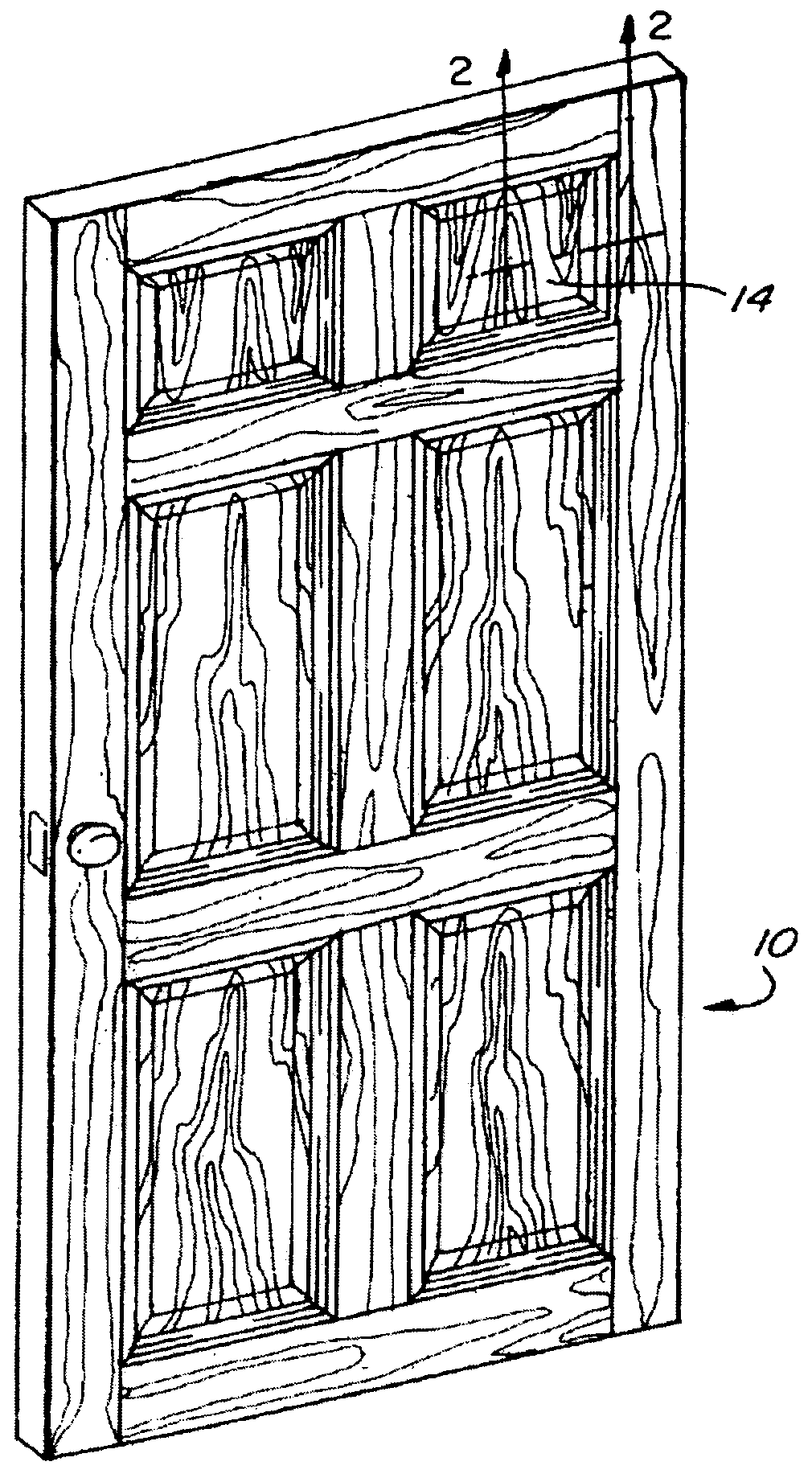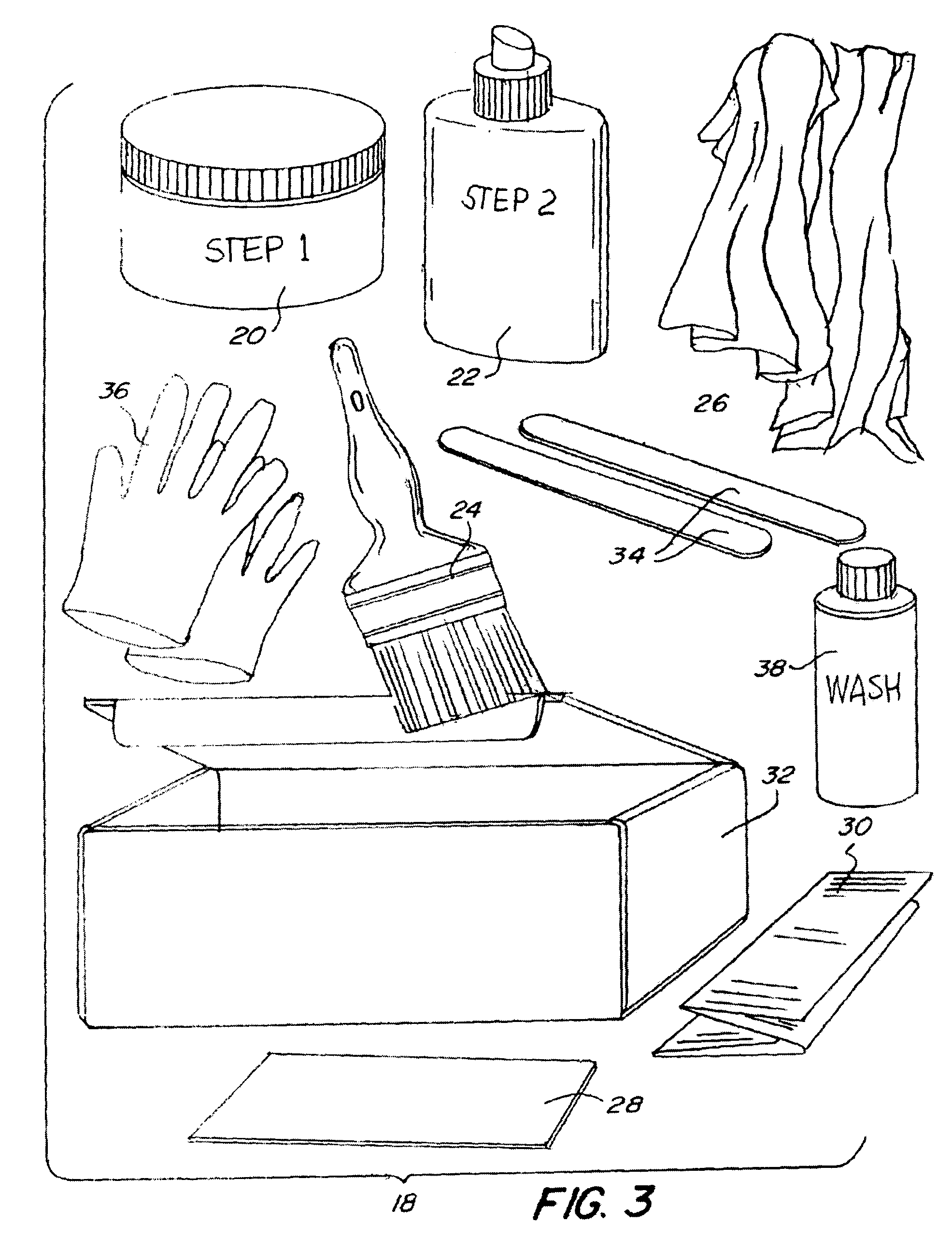Wood graining process
a graining process and wood technology, applied in the field of wood graining process, can solve the problems of difficulty in matching colors, less than desired use of solvents, and less than complete color treatment of stain coats,
- Summary
- Abstract
- Description
- Claims
- Application Information
AI Technical Summary
Benefits of technology
Problems solved by technology
Method used
Image
Examples
example 1
[0045]A door panel of the type illustrated in FIG. 1, having a surface of polymer sealed fiberglass, is finished according to the invention. A Step #1 (base coat) coating having the following formulation is applied by brushing on the door panel to achieve a non-running, even coat. Approximately 5 to 6 ounces is used to coat one side of a door having a surface area of 32 square feet. This formulation is prepared to simulate oak when used with an appropriately formulated Step #2 (grain coat) coating, but the pigments could be selected complimentarily to simulate other wood types.
Step #1 Coat Formulation
[0046]
IngredientParts by WeightSelf-Crosslinking Acrylic60.45Amine pH adjuster0.11Water5.44Glycol Ether Solvent7.12Associative Thickener0.25Nonionic surfactant0.18Anionic surfactant0.26Defoamer0.38Wax emulsion6.49Yellow Iron Oxide2.61Raw Sienna9.64Raw Umber1.16Titanium Pigment, white5.46Non-Urethane Thickener1.47Total100.02
Step #1 Coat Properties
[0047]
PropertyValueVolatiles, weight %59....
example 2
[0059]The Step #1 and Step #2 coating compositions of Example 1 were utilized according to this example to coat a door by a process which varied only in the manner of application of the Step #2 coating. In this case, the Step #2 coating was applied with a brush, applying 4 ounces to the door surface. Then, excess was scraped off with a paper squeegee, the surface was then wiped with a water wetted, damp cotton cloth. The results were essentially the same as those achieved in Example 1.
example 3
[0060]A door panel of the type illustrated in FIG. 1, having a surface of polymer sealed fiberglass, is finished according to the invention. A Step #1 coating having the following formulation is applied by brushing on the door panel to achieve a non-running, even coat. Approximately 5 to 6 ounces is used to coat one side of a door having a surface area of 32 square feet. This formulation is prepared to simulate oak when used with an appropriately formulated Step #2 coating, but the pigments could be selected complimentarily to simulate other wood types.
Step #1 Coat Formulation
[0061]
IngredientParts by WeightSelf-Crosslinking Acrylic72.7Amine pH adjuster0.03Water8.4Dipropylene Glycol Ether Solvent3.18Rheological additive0.30Nonionic surfactant0.26Dipropylene Glycol N-Propyl Ether Solvent4.77Defoamer0.35Quinacridone Red.07Yellow Iron Oxide3.65Burnt Sienna1.97Burnt Umber2.98Titanium Pigment, white1.30Non-Urethane Thickener0.03Total100.00
Step #1 Coat Properties
[0062]
PropertyValueVolatile...
PUM
| Property | Measurement | Unit |
|---|---|---|
| time | aaaaa | aaaaa |
| thickness | aaaaa | aaaaa |
| thickness | aaaaa | aaaaa |
Abstract
Description
Claims
Application Information
 Login to View More
Login to View More - R&D
- Intellectual Property
- Life Sciences
- Materials
- Tech Scout
- Unparalleled Data Quality
- Higher Quality Content
- 60% Fewer Hallucinations
Browse by: Latest US Patents, China's latest patents, Technical Efficacy Thesaurus, Application Domain, Technology Topic, Popular Technical Reports.
© 2025 PatSnap. All rights reserved.Legal|Privacy policy|Modern Slavery Act Transparency Statement|Sitemap|About US| Contact US: help@patsnap.com



